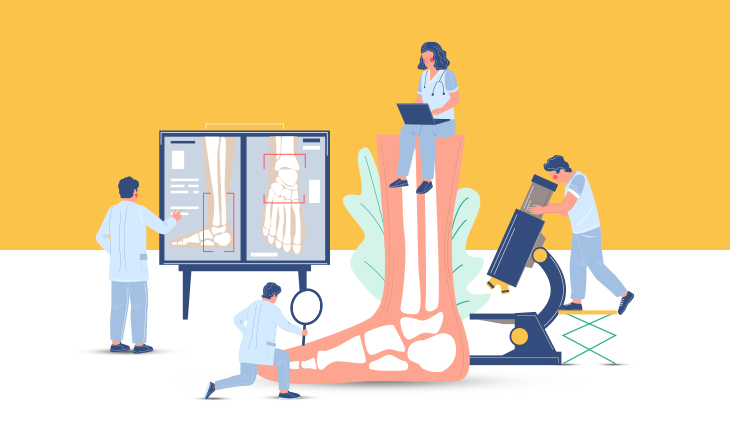
How To Prevent Side Stitches While Running

You are ticking all the right boxes as a runner. You train consistently, eat right, sleep well, and strengthen your mind to overcome challenges. And then, you experience the side stitch — the stabbing abdominal pain just under your rib cage on either side that may stop you from running.
Exercise-related transient abdominal pain (ETAP), commonly known as side stitch, side cramp, or muscle stitch, is a common complaint during exercise among runners and other endurance athletes. There is a higher incidence of side stitch, when upper body twists are involved during physical activity. It is reported that in a given year, 70% of runners experience a side stitch during their training. Many swimmers and horse riders also report similar pain during the course of their sporting activities. Frequent recurrences can be frustrating and often prevent athletes from performing their best in competitions.
What causes a side stitch?
Most runners, who experience a side cramp, feel localized pain in the abdomen when they exercise. The most common area is usually the right side of the abdomen, just below the ribcage. This pain can be sharp or stabbing at its worst, or a nagging pull, or a muscle cramp when it is mild.
The exact reason for side stitch is still not known. However, many mechanisms have been proposed, which may cause this debilitating, though short-lived, pain. A few of these are lack of blood flow to the diaphragm and intestines, bloating and stretching of the intestines, cramps in muscles of the abdomen, and irritation of the covering of the abdominal organs.
Younger athletes are more prone to side stitches than experienced ones, but it can still affect anyone engaged in intense physical activity. Consumption of sugary drinks before exercise can also lead to pain. While the resolution or recovery time is not well documented, decreased frequency is noted with avoidance of precipitating factors.
Also read: Why Is Cross Training Important for Distance Runners?
How can you treat it?
If the pain is present only during exercise and is completely absent at rest, then you can ignore it. Generally, the abdominal pain is resolved when activity is stopped.
Symptomatic treatment is usually all that is needed, and the stitch fades over time with rest. Deep breathing and manual pressure or massaging of the affected area are sufficient to alleviate the pain. Visit a doctor if the symptoms persist well after stopping physical activity
If you experience recurrent episodes of side stitches, it is advisable that you start creating a journal of what you ate and drank before your run, and also observe your pace and distance. Maintaining a journal will benefit you in recognizing the pattern and help you plan your runs better.
How to manage a side stitch?
1. Consume fluids and food in small quantities rather than a large volume at once before exercising. Before or during the workout, avoid beverages that are high in sugar content. Instead consume water or low-carb sports drinks.
2. Avoid eating high fat or high fiber meals one or two hours before exercising as they take longer to digest. The blood flow is thus directed towards the intestine for a longer period, while robbing the diaphragm of the much needed extra supply of blood and oxygen during exercise.
3. A proper warm-up before a high-intensity workout is essential, and in cold conditions, one should warm-up lightly indoors first.
4. Proper breathing technique can help get rid of side stitch. Breathing in through your nose and exhaling through pursed lips has been shown to reduce the frequency of side stitches in some runners. Your breathing patterns and diaphragm can have a big impact on cramping. To improve deep breathing, maintain proper running form and avoid slouching or hunching.
5. If your symptoms persist, a physiotherapist can work with you to encourage abdominal breathing and avoid upper chest breathing. Physiotherapy can also help you with exercises to improve mobility in the trunk, thus decreasing pressure on nerves and other abdominal structures.
6. Precompetitive psychological stress and anxiety can aggravate abdominal pain. The best way to combat stress is to stay calm and take deep breaths, which can help improve circulation and alleviate pain.
Side stitch often has simple solutions. Unlike other pains that runners experience, muscle stitch can have a quick resolution, often requiring no medication or a break in your training. Identifying and removing the precipitating factors can help reduce its incidence. Take time to uncover your triggers and get relief from ETAP.
References
1. Morton DP, Callister R. Factors influencing exercise-related Transient abdominal pain. Med Sci Sports Exerc 2002; 34: 745–9.
2. Morton DP. Exercise related transient abdominal pain. Br J Sports Med 2003; 37: 287–8.
3. Morton DP, Callister R. Characteristics and etiology of exercise-related transient abdominal pain. Med Sci Sports Exerc 2000; 32: 432–8.
4. Morton DP, Aragon-Vargas LF, Callister R. Effect of Ingested fluid composition on Exercise-related transient abdominal pain. Int J Sport Nutr Exerc Metab 2004; 14: 197–208.
5. Morton DP, Richards D, Callister R. Epidemiology of exercise-related transient abdominal pain at the Sydney city to Surf community run. J Sci Med Sport 2005; 8: 152–62.
6. Desmond CP, Roberts SK. Exercise-related abdominal pain as a Manifestation of the median arcuate ligament syndrome. Scand J Gastroenterol 2004; 12: 1310–3.
7. Boyle KL, Olinick J, Lewis C. The Value Of Blowing Up A Balloon N Am J Sports Phys Ther 2010; 5: 179–88.














